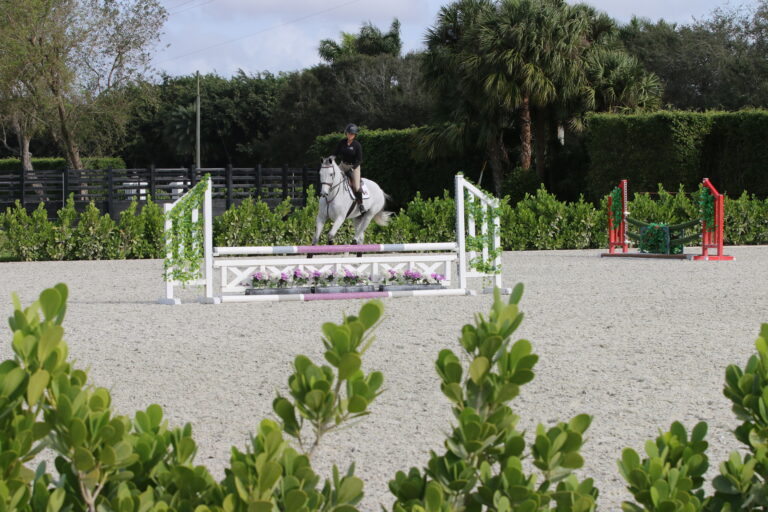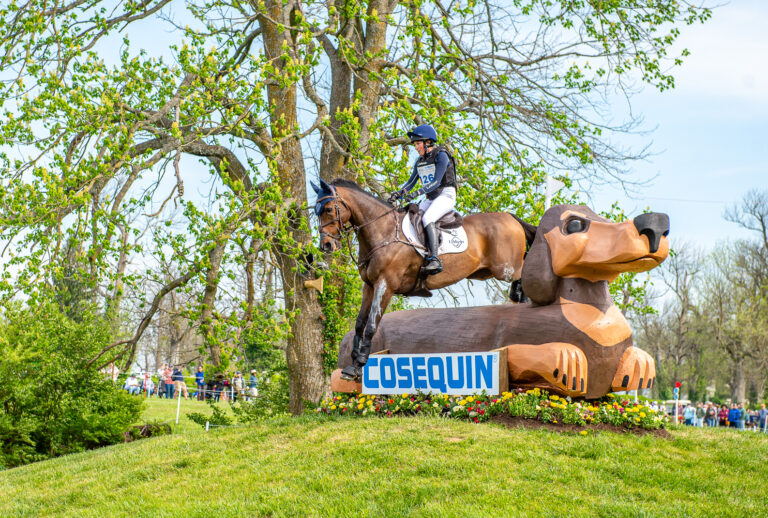How do I keep my horse’s head down in transitions?
Q: I am switching from hunters to dressage. I start out each ride by walking my off-the-track Thoroughbred for several minutes until his legs are stepping underneath him and he’s stretching and taking a light contact. But when I ask him to trot, he raises his head slightly for a few strides. What am I doing wrong in this transition?

© Amy K. Dragoo
MARY FLOOD
A: This problem is a common symptom of a lack of throughness, or longitudinal and lateral suppleness. As you correctly describe, to achieve throughness your horse must create energy in his hindquarters and transfer it over his back, withers, neck and poll into an elastic, yielding rein contact. He may seem to be on the bit—flexed at the poll so the front of his face is at the vertical—but still be stiff in his poll and/or leaning heavily on your hands. Or you may be holding him in a frame that appears round, but his head comes up the moment you relax the contact. In all of these cases, he’s not truly longitudinally supple and through.
Improving longitudinal suppleness is a two-step process. First, you ask your horse to yield in his jaw, lengthening along the crest of his neck and shortening his underneck. He then needs to make the connection through his entire topline from back to front. The best way to both test and improve this connection is with properly ridden transitions. They’re the glue between and within the gaits. To make that glue stronger, you must communicate with a correct position and appropriate aids. Here’s how:
Your horse’s body mirrors yours. If you tip your upper body forward during a transition, you’ll throw his balance onto his forehand. If you lean back and push with your seat, his back will hollow and his head will come up. So be sure to maintain the vertical alignment of your shoulders, hips and heels during transitions.
In dressage, ideally your seat aid should make up about 80 percent of your communication with your horse while your leg and hand aids are each about 10 percent. Using too much hand will cause him to avoid or brace against the contact. Similarly, squeezing your legs makes him feel constricted, causing him to drop his back, stiffen his shoulders and raise his head.
There are three types of seat aids:
- Neutral tells your horse to maintain whatever gait he is traveling in.
- Sending asks him to go forward, as in an upward transition.
- Non-allowing signals for a downward transition.
Practice these aids on a bar stool. Sit on its edge, first with a relaxed, vertical pelvis and upper body (neutral seat). Then advance your hips by rotating them forward until the stool tips onto its front legs. This is your sending seat. The motion you make with your hips to keep the stool from tipping too far and falling is your non-allowing seat.
In the saddle, use these seat aids to make transitions and regulate your horse’s stride length. Start with halt–walk and walk–halt transitions, using the sending seat and non-allowing seat, respectively. If he doesn’t respond to your sending seat, close your calves. If this doesn’t work, bump your legs or tap the whip either on his shoulder or directly behind your leg as you soften your hands slightly to allow room for him to step into the bridle. With repetition, he should tune into these go-forward signals and require less leg.
To produce effective downward transitions, make your shoulders and elbows heavier, then press your seat bones and thumbs downward. This will encourage your horse to accept your hand without bracing against you, being more likely to keep his topline shape while comfortably transitioning down.
Next, imagine you’re making an Oreo cookie, and the transitions within the gaits are the chocolate wafers. Focus on them before making the filling—the transitions between the gaits. Start with a regular walk, then use your non-allowing seat to ask for several shorter steps. Next, apply a sending seat to ask for bigger steps, following the motion forward with your hands. At first, don’t worry if your horse speeds up in the bigger walk and slows down in the shorter walk. The goal now is simply to adjust the size of the stride length.
Repeat this exercise at the trot. Ask your horse to respond promptly to your sending seat aid. Once in the trot, use your seat to request bigger and shorter steps, encouraging him to continue yielding in his jaw and poll as he adjusts his stride.
Gradually, as his suppleness improves within the gaits, you can work up to maintaining it during the transitions between them. For the trot–walk transition, use your non-allowing seat to ask for a slower and slower trot until he walks. He should be so balanced and on the aids now that it won’t occur to him to raise his head. The same thing will happen eventually in the walk–trot transition. Just keep building both sides of that Oreo cookie until you work your way into the center. Then the filling will glue it all together.
Mary Flood has spent more than 40 years refining her dressage techniques, incorporating her experience in eventing, show jumping, hunters, competitive trail riding and Western riding. An FEI trainer and competitor and USDF national-level certified instructor and bronze, silver and gold medalist, she has earned awards such as the Grands Prix at Dressage at Devon and the Festival of Champions in 1990. A popular clinician, she has coached students to achievements including representation at USPC National Dressage Finals and three USPC “A” ratings. Her training facility, Wildfire Farm, is based in Lovettsville, Virginia.
This article originally appeared in the June 2015 issue of Practical Horseman.











